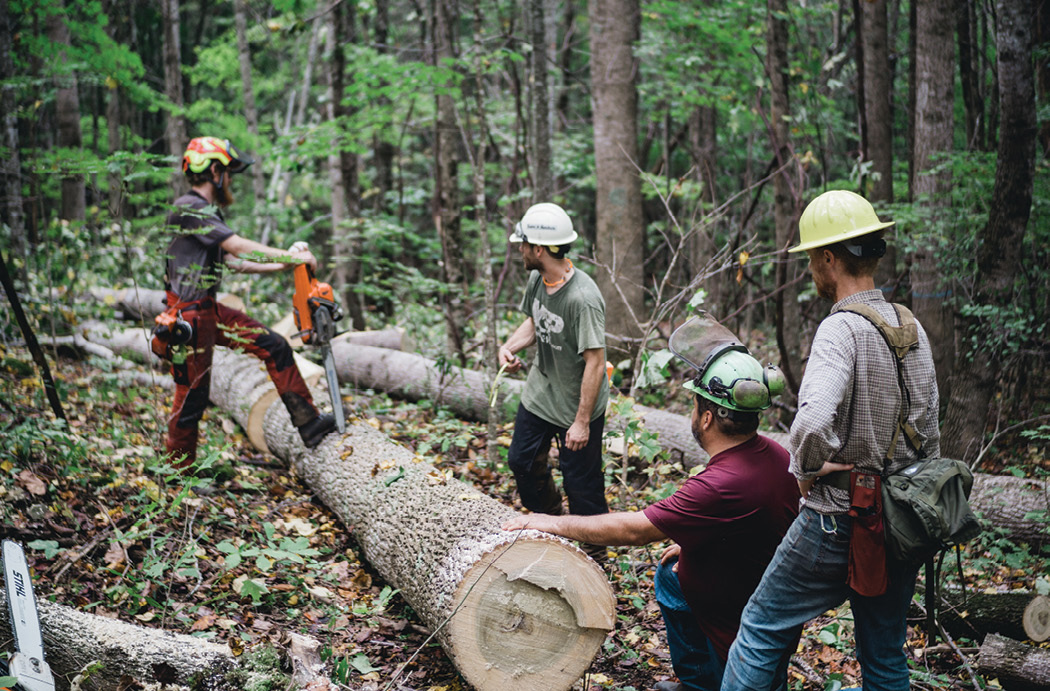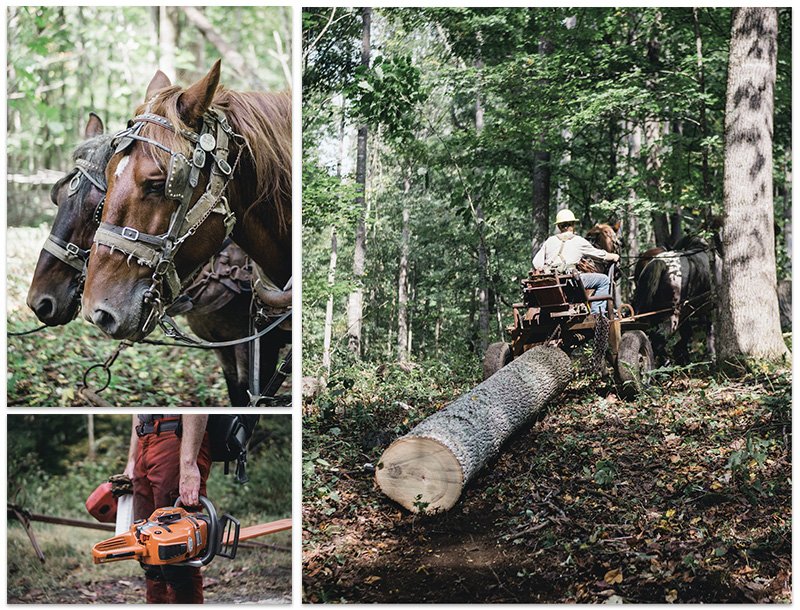Horse Power
Horse Power: A return to an old-fashioned logging method means a healthy future for our forests
A Cut Above - The loggers rely on precisely tuned chain saws and teams of massive Suffolk draft horses. A team can quickly and nimbly remove lengths of timber from the woods.
When a tree is felled in a forest, it isn’t just a sound—it’s a multisensory experience amped up on adrenaline. First, there’s the throbbing buzz of a chain saw and desperate warning cries from one woodsman to another to get out of the way. Then the telltale crack as the trunk gives way, followed by a whoosh of unleashed energy, a rainstorm of leaves and branches coming down, and finally an earth-shuddering thump as the tree smashes and bounces off the ground in a single 100-foot length, eventually settling into silence. As with commercial logging, the sylvan giant must be transported. In this case, draft horses do the job.
It’s a rowdy ordeal, but lumberers like Ian Snider and Ian Anderson, along with draft horse wranglers like their partner, Chad Miano, aim to ultimately make the process as least disruptive as possible. Theirs is a sustainable approach to forestry, which takes commercial logging a few notches back in intensity, a few generations back in technique, and an eternity in philosophy.

Survey Says - Nathan Mullins evaluates the commercial potential of a fallen tree before the horses transport it to a hauler waiting at the roadside.
Tread Lightly
As an owner of Mountain Works Sustainable Development, Inc., Snider is part of a thoroughly up-to-date new generation of loggers—including women—heading into the woods of WNC to take a gentler approach to logging, using sustainable and holistic techniques that take forest health, not just marketable yield, into consideration.
Their way includes using draft horses instead of track-driven haulers, grapplers, and skidders; years-long rather than months-long harvest schedules; and the hand selection of nearly every tree to be cut, depending on a mind-boggling array of desired outcomes: customer orders for exact lengths and numbers of logs, the clearing of small weedy trees to allow more valuable specimens to mature, the creation of forest conditions to nurture specific species like sugar maple and oak, and the fulfillment of market demand for plywood veneers and decking and pulpwood and posts.
For some years, Snider ran a silvicology program at Appalachian State University, putting his commercial work to one side. With that program no longer offered, he has returned with renewed focus to Mountain Works, based in Zionville in Watauga County. He sees the forest not just as a place to harvest wood, but also as a complex biological system that can support life for future generations.
As he works toward a PhD in Forestry at Clemson University, his company innovates with programs like Community Supported Forestry, similar to the popular Community Supported Agriculture system of direct-to-customer crop sales instead of mass marketing through wholesalers.
“There’s more people calling me for the work I do than I can ever do before I’m dead,” Snider says matter-of-factly. “The work that I’m doing now will live on after I’m gone.”
Using draft horses instead of mechanical means to move cut timber from woods to roadside is an important component of forest health. The horses tread lightly—despite weighing nearly a ton apiece—which preserves the soil structure. Strong soil, which teems with hard-working and diverse microbes, creates better growing conditions for trees; stronger trees help pull more carbon from the atmosphere and make for better water retention and less runoff. It’s a long but important cycle.
“Humanity is not separate from the forest. The forester is in fact part of the forest,” says Snider. “The woods are amazingly alive.”

Careful Calculation - Horse wrangler Chad Miano (second from right above) works out the safest and most efficient transportation route with the loggers before hitching his team to the trunk.
Science & Sustainability
Commercial logging ranks as the most dangerous job in America. As Anderson says, “There are a million ways to get hurt in the woods.”
So the technical side of sustainable logging is just one step in a complicated dance, involving precision in all aspects of power tool operations and safety protocols. Then there are the teams of Suffolk draft horses: gentle giants, bred for their power and their ability to respond to a score of voice and rein commands, that are more reliable than motorized vehicles. Finally, there’s the science, requiring not just book learning but a feel for the dynamics of a particular piece of land, including animal and bird habitat, sunlight, moisture, topography, and soil composition. Add to those considerations the goals of each landowner and a time horizon as long as a decade to manage a single logging operation sustainably.
“This isn’t rocket science,” Anderson says. “It’s much more complicated.”
Clear cutting is simple in comparison. Cut as much of the valuable timber as possible and move on. Eventually new trees grow, but damage to age-old ecosystems may be severe. Snider contends that a sustainable logging approach can mitigate climate change. “The longer time frame of logging with horses helps take care of the environment. Money is a by-product.”
The sustainable model, as practiced by Mountain Works and other companies, begins with the process of evaluating the land in partnership with the owners. Snider says there are as many different goals for today’s landowners, many of them women, as there are owners themselves. Some want to harvest wood on site to build their homes, creating an intimate pairing of trees and their uses. Some want to open up land for raising livestock while preserving the benefits of the forest. Some want to thin out small or undesirable trees for the land’s long-term productivity.
In any case, Snider shares that work doesn’t begin until three things are in place: a management plan, tree inventory, and assessment of resources. Only then do the logging teams go into the woods to mark individual trees. So precise is the process that a stand of trees may be selectively logged with no apparent change in the land’s appearance. It’s a go-slow approach.
In using the popular Community Supported Forestry system, clients can order exactly what they need and eliminate some of the waste from “store bought” dimensional lumber. At present, Mountain Works forest products include exterior siding, shingles, support beams, flooring, paneling, even fuel.
While the system helps the harvest stay local, it also benefits the economy. And the approach to logging and use of draft horses will ensure healthier woodlands for the future.
At Your Service
Mountain Works Sustainable Development, Inc. provides forest products, construction, and land management services throughout WNC and beyond. One of the most unusual commissions was a call from a Trappist monastery in Georgia that had been damaged by a tornado. The monks called the horse loggers to clear trees from a sacred burial ground. Find more information at mtnworks.org.
